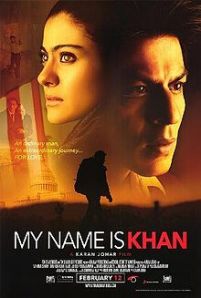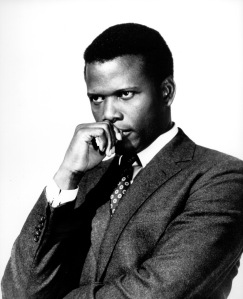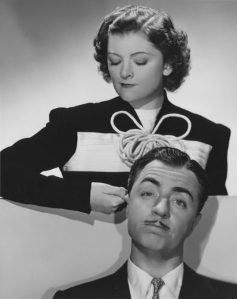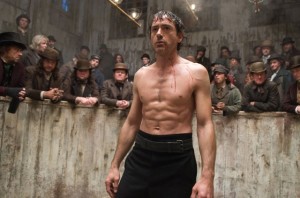My Name is Khan was a crossover success for Indian film director Karan Johar. The film is set in America and has a large amount of English language content. For many Americans, this film served as an introduction to Indian cinema and two of its biggest stars—Shah Rukh Khan (also billed in some films as Shahrukh Khan), who plays the lead character, Rizvan Khan, and Kajol, who plays his wife, Mandira.
The film tells the story of an Indian man with Asperger’s Syndrome in post-9/11 America who takes his wife’s challenge to “go tell the president who you are!” seriously and makes a journey that takes him on a cross-country tour of the U.S. as he tries to meet the president and explain that he is not a terrorist. It also a story about a mixed marriage as Khan is Muslim and Mandira is Hindu (as a bit of trivia, Shah Rukh Khan is Muslim and married to a Hindu in real life; Kajol is Hindu).
Some critics have compared the film to Forrest Gump and there are definitely parallels between the two films, such as Khan’s and Forrest’s journeys which put them in the path of people and events that make the news; the way both men change the people they encounter; and the quests they embark upon.
My Name is Khan will seem familiar in some ways to American viewers because of the similarity to Forrest Gump and some parts of film narrative and production are common to both Indian and American cinemas, such as the use of flashbacks and the use of close-ups to convey the characters’ emotions and responses.
There are also some aspects that are much more typical of Bollywood: the length of the film, the use of melodrama, musical numbers to extend the narrative, choreographed crowd scenes, and using the camera to revolve and swirl around characters to convey a sense of emotional distress.
Bollywood elements of the film
Melodrama is one of the staples of Indian cinematic narrative. Plot (and often overly theatrical acting) weighs more heavily than characterization. In My Name is Khan there are several events that move the plot forward and which may seem too predictable or too heavy-handed to American viewers, such as the deaths of Mark and Sameer. Khan’s arrest, beating, and release from prison are another example. Any of these events on its own might work in a typical American film, but all of them together pushes the limits on the American viewer’s ability to suspend disbelief. In Indian cinematic tradition, the use of melodrama is expected—the characters usually have every single crutch or support device ripped away from them over the course of a film so that when there is resolution in the end, the viewer has a sense that the character has overcome absolutely all odds to reach victory.
What makes the melodrama of My Name is Khan palatable for American viewers is Shah Rukh Khan’s acting. He refrains from doing overblown acting through most of the film and is usually very believable as Khan, stuck inside his mind and unable to process the unspoken emotions and responses of other people. Shah Rukh Khan lets the slightest flickers of expression around his mouth and eyes tell the story as Khan makes discoveries and realizations about the world he encounters.
While American movies use music in their soundtracks and sometimes have characters who sing snippets of a song in a scene, Hollywood movies generally don’t use songs to advance narrative unless the film is a Musical. In Indian cinema, musical numbers are expected in almost every genre. While there are no big dancing numbers in My Name is Khan, there are a few places where a song is used to move the story along. A song starts when Madira cuts Khan’s hair and turns into a montage of the pair falling in love. The closest we get to an all-out song and dance routine is during the memorial service at the church where Mama Jenny and the congregation sing “We Shall Overcome” and Khan joins in.
An example of a more typical musical number in Indian cinema is this piece from Mission Kashmir:
In the film, the two characters in the scene were childhood friends who haven’t seen each other for years; the man, Altaaf, has been groomed to be a terrorist and he originally plans to use the woman, Sufiya, to gain access to a TV station where she works. Here, he fakes his way into a performance she is doing of a song that is sometimes played on the night a Kashmiri bride-to-be is painted with henna. At the end of the performance Sufiya has a flashback to her childhood and singing the song with Altaaf; she recognizes him and they are reunited.
Many of the post-9/11 events in the film are designed to show the anti-Muslim sentiment in America at the time (and which is still lingering). Again, some of these incidents fall into the realm of melodrama: for American viewers, it is hard to buy the idea that Reese and Sameer would be best friends for seven years and then Reese would suddenly stop speaking to Sameer after his father dies in the war in Afghanistan. The other kids at school believe Sameer is a Muslim, but surely his best friend would know Sameer’s true character (and that he is Hindu).
American viewers might also be thrown off by the overlapping events and subplots in the film—as Khan makes his way across the country, new characters and situations are introduced and the film goes back and forth with these scenes and the larger story of Khan’s journey.
‘There are only two kinds of people in the world’
The character of Mama Jenny is interesting in light of our previous discussion of the representation of blacks in Hollywood films. In My Name is Khan, Mama Jenny is close to the stereotypes of a Mammy character and what Spike Lee calls “the magical, mystical Negro,” a character who has special spiritual, healing, or magical abilities. Mama Jenny’s spirituality and generosity are supposed to show that Khan’s mother’s assessment of people was right; his mother told him religion doesn’t really matter, that there are two kinds of people in the world: good and bad. Mama Jenny is supposed to be a “good” one. While the intent of the character is good, the characterization may be flat and stereotyped to American viewers when they see Mama Jenny in her big skirt and head-wrap that are eerily similar to Aunt Jemima’s or her life in a ramshackle cabin that is eased by her involvement in her church. This type of portrayal is so common in the films and TV shows that America exports, the representation is picked up and reproduced in other cultures.
The film tries to show that Khan’s mother was right about the two types of people in the world by contrasting Mama Jenny with the woman at the fund-raiser who tells Khan it is “for Christians only” and by showing different types of Muslims over the course of the film. We are shown Khan and his mother, his brother, and his sister-in-law as “good” Muslims. Khan is shown praying in several and his sister-in-law wears the hijab, but we don’t get much perspective on what they think or believe—again, this is where plot and action take precedence over fuller character development. In contrast, the “bad” Muslims are shown in the mosque inciting one another to violence.
By the end of the film, we don’t get too deep into any of the characters, which may seem odd to American viewers who are used to films that often follow the literary expectation that a character must grow in some way or change perspectives by the end of the film. Part of this may be a cultural difference: in America, there is much focus on “the individual” and we expect a certain amount of depth and motivation to explain a character’s actions. In other cultures where family and group take precedence over the individual, storytelling may focus on actions and consequences of events rather than an individual’s unique understanding of those events.
Film Terminology
Diegetic Sound—the sounds a character can hear on screen, even if the source is not visible (e.g. birds chirping or music playing on the radio). Non-diegetic sound is not implied to be part of the character’s environment (e.g. narration or music that swells in the background during a suspenseful scene). The music that plays when Mandira cuts Khan’s hair is non-diegetic; when Khan, Mama Jenny and the congregation sing “We Shall Overcome,” it is diegetic sound.
Flashback—interrupting chronological sequence by injecting scenes of earlier events unfolding.
Melodrama—the use of extravagant theatricality and the predominance of plot or physical action over character development.












